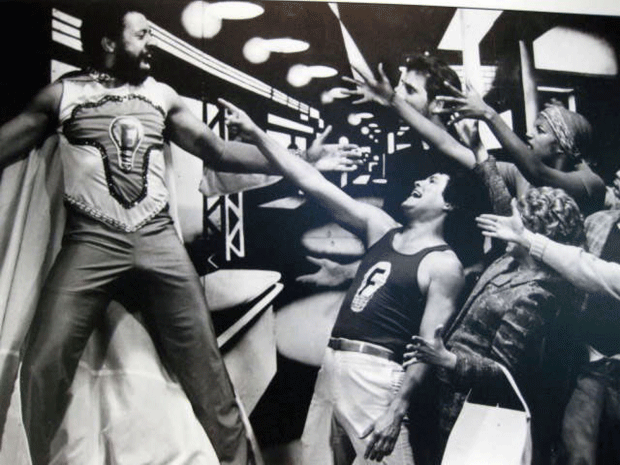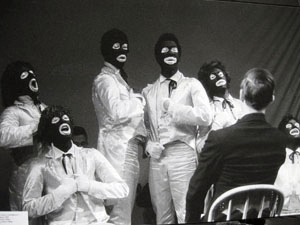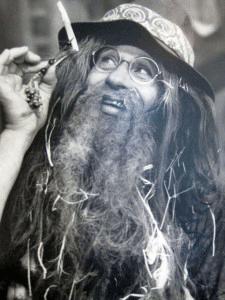
S.F. Mime Troupe Turns 50
Mark Rabine
December 10, 2009

Bored with middle-class American life, R.G. Davis fled from Ohio to the Mission District in San Francisco (via Paris and New York) where 50 years ago he founded the San Francisco Mime Troupe.
To celebrate the anniversary, two public exhibitions and an event tonight trace the remarkable career of a Mission institution with a global reputation.
The event at Yerba Buena Center for the Arts runs from 7:30 p.m. to 11:30 p.m.. Expect to see VICs (Very Important Characters) and a performance of the Troupe’s short play Ghosts. And why not? In the wake of President Barack Obama’s Johnsonesque-calation of the war in the Hindu Kush, a lot of specters should be coming home for an encore.
Two exhibits help round out the Troupe’s story.
“Engagement, Commitment and Fresh Air – Celebrating 50 Years of the SF Mime Troupe,” on exhibit at the Yerba Buena Center’s Room for Big Ideas, is a multi-media installation replete with time lines, videos, costumes, props and posters. It feels unfinished, which is good, but also disordered and slightly too much, which is not so good.
“Free in (g) the Parks,” tucked into a corner on the Fourth Floor of the Main Library, tells the story of the Troupe’s struggle in the 1960s to perform for free in public parks. The back and white photographs and news clips tell a more focused story than the Yerba Buena exhibit and gives a better sense of the cultural and political environment that produced the Troupe. Without a sense of this stage, it’s hard to appreciate what the Mime Troupe was and what it has become.
Here are excerpts from the San Francisco Chronicle, dated August 23, 1963, reporting on a meeting of the city’s Recreation and Parks Commission:
The Recreation and Park Commissioners, who normally don’t get into such things, were forced to decide yesterday if the San Francisco Mime Troupe might not be a little too sexy.
The troupers had asked permission to give a series of free shows this month and next in the great tradition of commedia dell’arte, which by their own definition, is “spicy.”
“Spicy” was also the word used by two apparently horrified parents in describing one of the troupe’s previous engagements.
“They seemed to feel,” reported Recreation Superintendent James P. Lang, “that it was all right for adults but not good for children.”
Lang was promptly asked by Commission President Walter A. Haas for a definition of “spicy.”
“I would be inclined to say,” replied the embarrassed superintendent, “that the emphasis would be on sex.”
The testimony of two children aged 13 and 10 (via a column in the Chronicle) appeared to save the day for the Mime Troupe.
On a motion from Commissioner Dr. Francis J. Herz, the commission voted unanimously to let the show go on – with the proviso that if spiciness ever drifted unhappily into sexiness the Mime Troupe would be silenced.
Unhappily, three weeks later, the commission pulled the plug.
Though times and the Mime Troupe have changed, the Troupe will be forever branded as an icon of the 1960’s counterculture. R.G. Davis was far from alone. For many of that era, the restless desire for personal emancipation sparked the imagination for peace and social justice. This imagination, the ideals and values it expressed, carried the Troupe through the dark ages of Reagan, the darker ages of George W., and continue to make the Troupe relevant today.
Shortly after Davis moved to San Francisco, he set up shop in the Mission. An ethnic working class neighborhood in transition, the Mission provided cheaper rents, and warmer nights, for young artists who wanted to make love instead of a living. An abandoned church at 20th and Capp streets served as the Troupe’s first home. From there they moved to 450 Alabama, and then to the current home at 855 Treat, identified by a fading Juana Alicia mural illustrating the Mime Troupe’s history.
At its best, the Mime Troupe thought locally and acted globally. They took a local situation, or issue, and explored its global ramifications, “raising consciousness” and taking its show on the road. From 1970 with Los Siete, about the frame-up of Latino youth for the murder of a San Francisco policeman, through City for Sale in 1999, the sixth play about urban displacement, the Troupe repeatedly used the Mission as a source of dramatic material and political inspiration.
Like many of its neighbors (who were often the audience and sometimes the cast), the Troupe considered itself left, very left, of center, so “local” issues in the Mission incorporated the war in Central America, religious fundamentalism, and industrial plant closings.
Unlike most theater companies around the world, the Mime Troupe took its politics seriously. Even in the 1960s, Mime Troupe shows were not just busted for “indecency” and “obscenity.” The performances most often harassed were the most controversial like the devastating civil rights parody that was A Minstrel Show and the biting anti-war farce L’Amant Militaire, which a Des Moines, Iowa critic slammed as “shocking”, “unpatriotic”, “blasphemous”, before confessing “I don’t know when I’ve enjoyed an evening of theater more.”

A Minstrel Show, or Civil Rights in a Cracker Barrel, 1965 created my a racially mixed group of SF Mime Troupe performers
In 1969, increasingly at odds with his company, Davis left and the Troupe became a political collective. As such, the Troupe was not unique in the Mission, where all manner of political collective flowered, and died. Though the Troupe suffered the same fate politically, it won national awards and international recognition as a theater company. The talent and performance level have always been high, but it was the politics that made the Troupe stand out, and it still is. In a theatrical world dominated by dramas of family dysfunction and alcoholism (talk about boredom!), a musical about displaced immigrants, U.S. foreign policy in Africa, or winos South of Market, is still strange enough to get noticed.
Today, the Mime Troupe no longer functions like, or describes itself as, a political collective. Although the performances continue to reflect a strongly progressive critique of the current social/political climate, the Troupe no longer ignites controversy, or excites the passions of otherwise comatose Commissars at Rec and Park. Many of the radical positions the Mime Troupe took in the Sixties are now mainstream — an anti-war play in 60’s could get you busted; today, an anti-war play can get you into theater school at Yale or UCLA. As an institution, with employees and budgets heavily dependent, like any theater company, on public funds and foundation grants, the Troupe cannot afford the risks of transgression. And at 50, who’s going to get busted for “sexiness”?

Ripped Van Winkle
For the new generation of artists and activists moving into the Mission, the Mime Troupe must resemble the character Ripped Van Winkle, a middle-aged hippie who, in the play by the same name, swallows a tab of purple acid in 1968 and wakes up in 1988. What to make of this guy who definitely seems to have walked onto the stage from a radically different age. A Wanderer? A Fool? A Specter?
Or, as the Troupe’s latest performance, Too Big to Fail, suggests, a Storyteller.
With lots of stories still to tell.